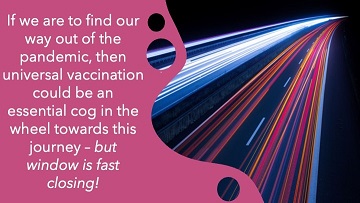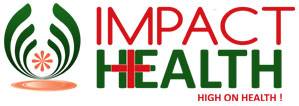Step up the pace globally if universal vaccination could lead us out of the pandemic
The COVID pandemic has hard drilled the lesson why health and social security of each one of us is inter-dependent on health and social security of one another. But do we see more equity (or inequity) in the COVID response, such as the rollout of the vaccination worldwide? Inequitable distribution of vaccine, diagnostics, oxygen, personnel protective equipment, and other necessary essential tools have been plaguing the COVID response due to which we are unable to fully break the chain of infection transmission by prevention measures, and reduce severity of the disease for those who get infected.

Global population is around 7.8 billion people. World Health Organization (WHO) Director General DrTedrosAdhanom Ghebreyesus said that globally 5.5 billion doses of COVID vaccines have been administered but 80% of these vaccinations have happened in rich nations. Rich nations promised to donate 1 billion doses but less than 15% of this promise has been kept so far.
The WHO is mobilizing all countries worldwide to vaccinate 10% of population fully by September 2021, and 40% by December 2021, and 70% by June 2022. 90% of rich nations have already reached the target of fully vaccinating at least 10% of their population, and 70% of rich nations have already reached 40% target. But not a single low income country has reached either of the targets so far, alarmed DrTedrosAdhanom Ghebreyesus.
That is why DrTedrosAdhanom Ghebreyesus is appealing to all the governments not to give booster third dose of Covid vaccines till end of this year so that everyone worldwide can get a chance of being fully vaccinated. If we are to find our way out of the pandemic, then universal vaccination is an essential cog in the wheel towards this journey – but window is fast closing!
India which began COVID vaccination on 16 January 2021, reported over 20% full vaccination of eligible population by mid-September 2021. Noted infectious diseases expert Dr Ishwar Gilada, Secretary General of Organized Medicine Academic Guild (OMAG) said that “We applaud the efforts of healthcare and frontline workers who have toiled in taking the COVID vaccination drive to a new heights and creating a global record. On 17 September 2021, India vaccinated 25 million (2.5 crore) people, which is more than it had done in the first two months when the vaccination began (India had vaccinated 24.4 million (2.44 crore) during 16 January-14 March 2021). We expect the pace is maintainable and not unique for the day.”
Maintaining the pace of over 10 million vaccinations daily is a long-standing promise of Indian government but we were able to meet it thrice before 17 September 2021. For instance, in the week preceding the 17 September feat of achieving 25 million vaccinations in 24 hours, India had vaccinated between 5.3 million to 7.8 million daily.
Average vaccine doses per day have been on a consistent rise in India in preceding months, but fall short of 10 million doses per day desired (and promised) average. Average doses per day in May 2021 in India was 19.69 lakh (1.969 million) doses daily, in June 2021 the average rose to 39.89 lakhs (3.989 million) doses daily, in July 2021 the average further went up to 43.41 lakhs (4.341 million) doses daily, and in August 2021 the average doses per day reached 59.29 lakhs (5.929 million). So if we are to achieve universal vaccination of all eligible population, we need to maintain the pace of 10 million (or more) doses administered daily, and not just on special occasions.
DrSuneela Garg, President of OMAG and DrGilada wrote in their communique that while comparing India with other nations we should use science-based data of number of people infected or dead due to COVID per million population (or lakh), and not absolute numbers. For example, as on 18 September 2021, India ranks125th in COVID cases/million population and 120th in deaths/million population in 221 countries globally.
OMAG leaders DrGilada and Dr Garg call for equitable rollout of vaccination. “The challenges in terms of gender inequality need to be addressed through gender sensitive policies, programming and healthcare services, which includes friendlier vaccination timings. The elderly population and difficult to reach population needs to be provided vaccines at the doorsteps. At no stage we can afford to be complacent with regard to vaccinations, addressing vaccine hesitancy, continued covid-appropriate behaviour and looking for new variants of concerns through genomic studies."
Of the six COVID vaccines licensed in India so far, 90% supplies are of Covishield, 9.6% of Covaxin and 0.4% of Sputnik. Moderna (licensed to Cipla for marketing), Johnson & Johnson single dose vaccine (licensed to Biological-E for domestic production) and ZyCovD of ZydusCadila are yet to make a debut. Alongside scaling up the supply side, it is equally important to expand India’s capacity manifold to export vaccines to those countries in dire need of vaccines.
Malaysian Health Minister Khairy Jamaluddin tweeted that "The COVAX facility has failed. Rich countries continue to hoard vaccines. Big pharma prioritise delivery to rich countries. My country had to fight this inequity to become top 35 most vaccinated country in the world. What about poorer countries? World must fight this injustice." Let us hope we do not miss the chance to find a possible way out of the pandemic via universal vaccination worldwide before the window closes.
About Author
Bobby Ramakant is a World Health Organization (WHO) Director General’s WNTD Awardee 2008 and part of editorial team of CNS (Citizen News Service) and Asha Parivar. Follow him on Twitter @BobbyRamakant
